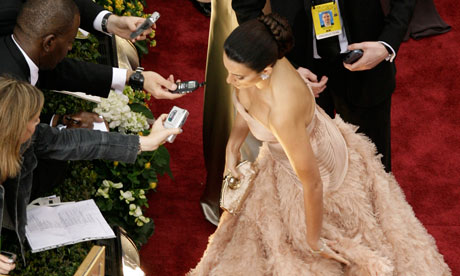
Oscar weekend is approaching, and despite the tonnes of commentary that attach to every aspect of the Academy Awards, there is one tradition that could do with more critical scrutiny: the "red carpet interview". One day there will be a PhD thesis – perhaps there is already – deconstructing the iconography and implied ideology of this increasingly important pre-ceremony convention.
The stars, theoretically intent only on strolling from the limos to the theatre, pausing perhaps for pictures, spontaneously consent to being waylaid by an ebullient, deferential interviewer, and come over for a quick, adoring chat across the velvet rope that separates the talent from the mortals. Interviewers such as Ryan Seacrest and Isaac Mizrahi have become famous for this.
But the clip here shows that the red carpet is not a straightforward roll of red carpet, but a tightly policed series of pens:
The scene at the beginning of The Artist, in which an ordinary member of the gawping public somehow breaks past the police line for a serendipitous encounter with the star could not happen now.
Whenever I hear the term "Hollywood royalty", I always think of the red-carpet encounter: the choreography of the interview is shaped by the British royal walkabout. When Mark Wahlberg chats with E! Entertainment about who designed his tux, his body language looks very similar to Wills and Kate coming over for a wonderfully informal word with RNLI workers, or the Queen dispensing Maundy money to the poor. But there is a reversal: the royal prerogative of speaking first and asking questions (of the most gentle sort) belongs to the humble interviewer for whom phrases such as "Who designed your dress?" is not so far from the Queen's anodyne: "Have you come far?"
Often, stars will wait their turn to be interviewed, and you can spot them in the background, conferring with their publicists, or posing for a few more pictures. It's pretty strictly controlled. Occasionally, but rarely, you see two stars meet in front of a red-carpet interviewer's microphone, as Jodie Foster and Morgan Freeman did in 1990:
They did not know each other, and the interviewer actually presumed to introduce them, live on air. The stars were genial and good-natured but glazed – the status-ranking was skewiff, as if a parish priest were introducing St Matthew to St Paul. The interviewer, in having made the introduction, was for a billionth of a second their equal.
Occasionally, some stars, such as Lethal Weapon's Gary Busey in 2008, appear to be very convivial and exuberant for their red-carpet appearance, as you can see here:
and here:
Viewers of London's Bafta ceremony will already know that a new red-carpet star has been born. Miss Piggy did the interviews, all the while seething that she hadn't been nominated, her snout twitching with resentment:
Like the puppets in Team America, though in a far more affectionate way, her presence satirised the actors and she provided a gentle mockery of the red-carpet tradition itself. Miss Piggy's interview with Michael Fassbender was a gloriously surreal moment, taking the genre to new levels, as she confessed to him she was hoping to take Kermit to see the searing sex-addiction drama Shame because it was so "steamy". Only Miss Piggy could have got away with it. She is apparently doing an Oscar presentation with Kermit. That's a waste. She should do the red-carpet interviews: it's her destiny.

